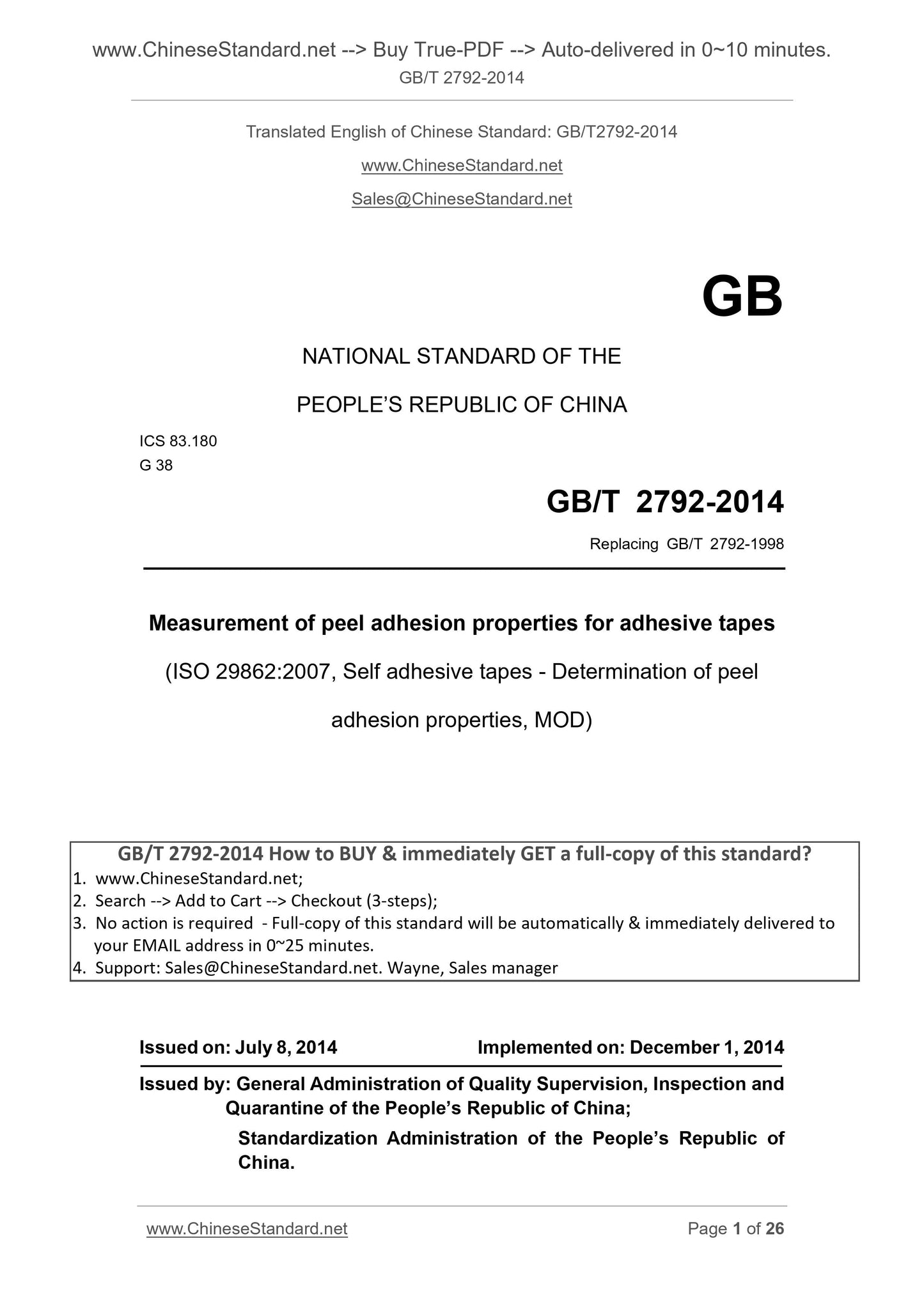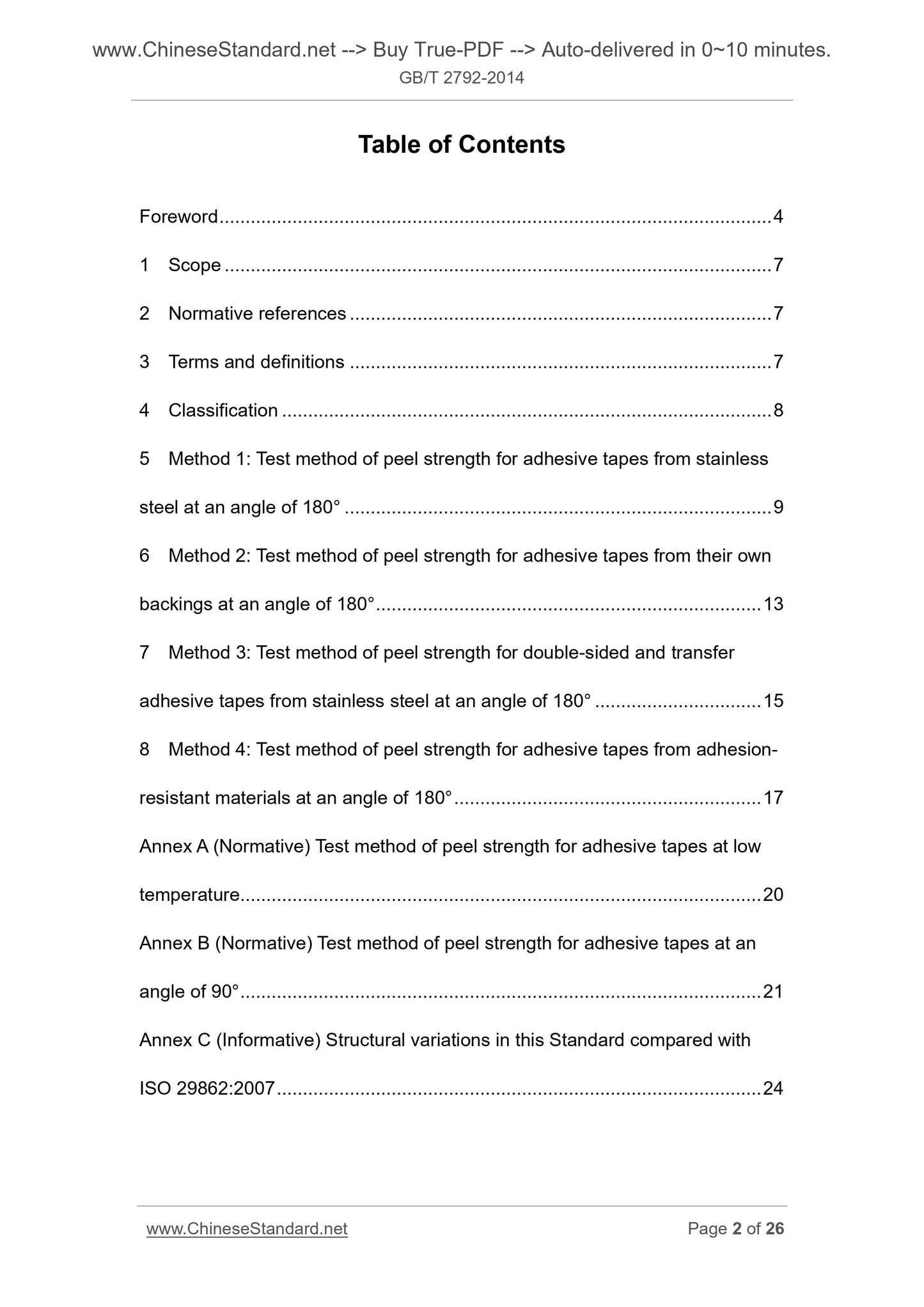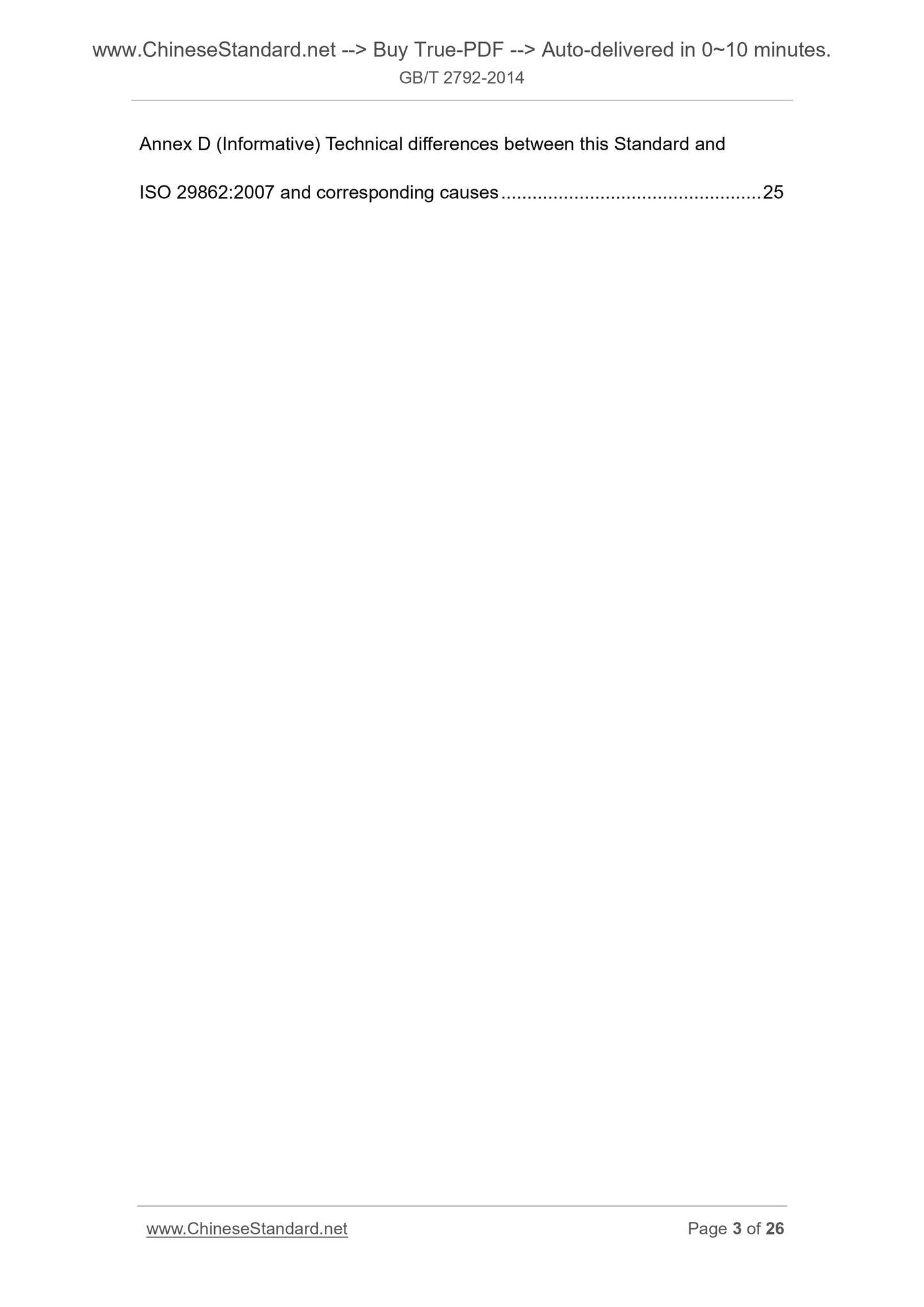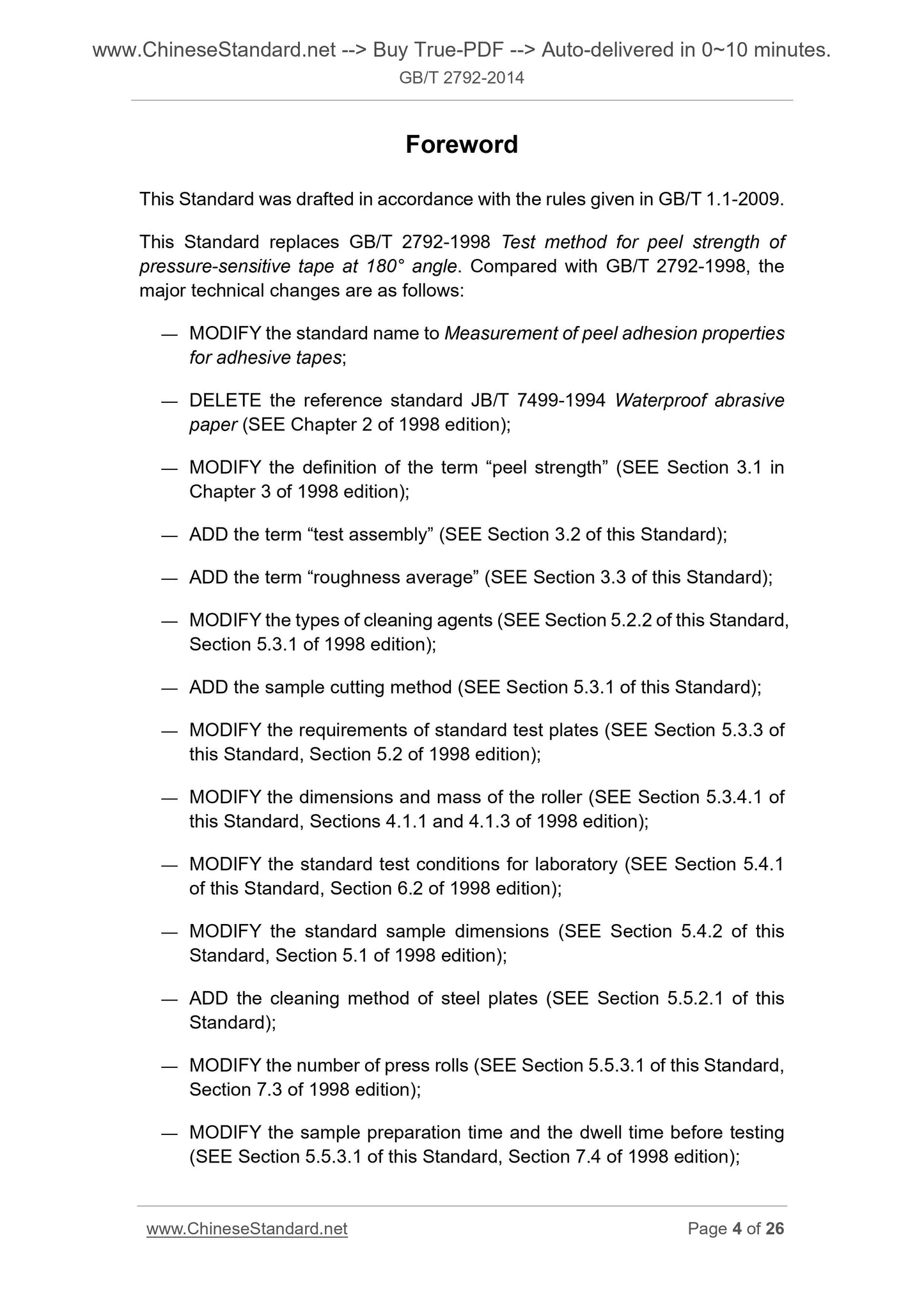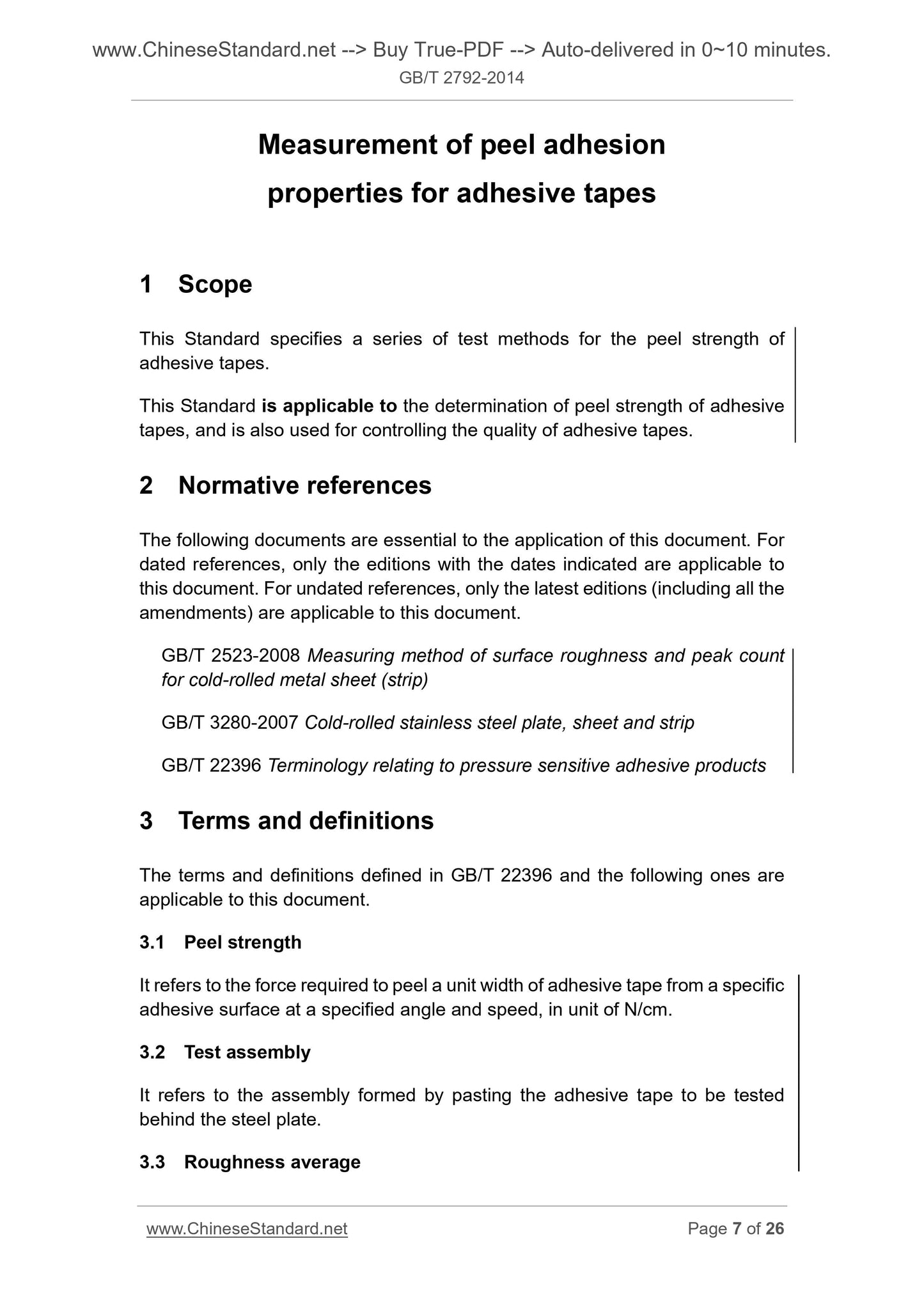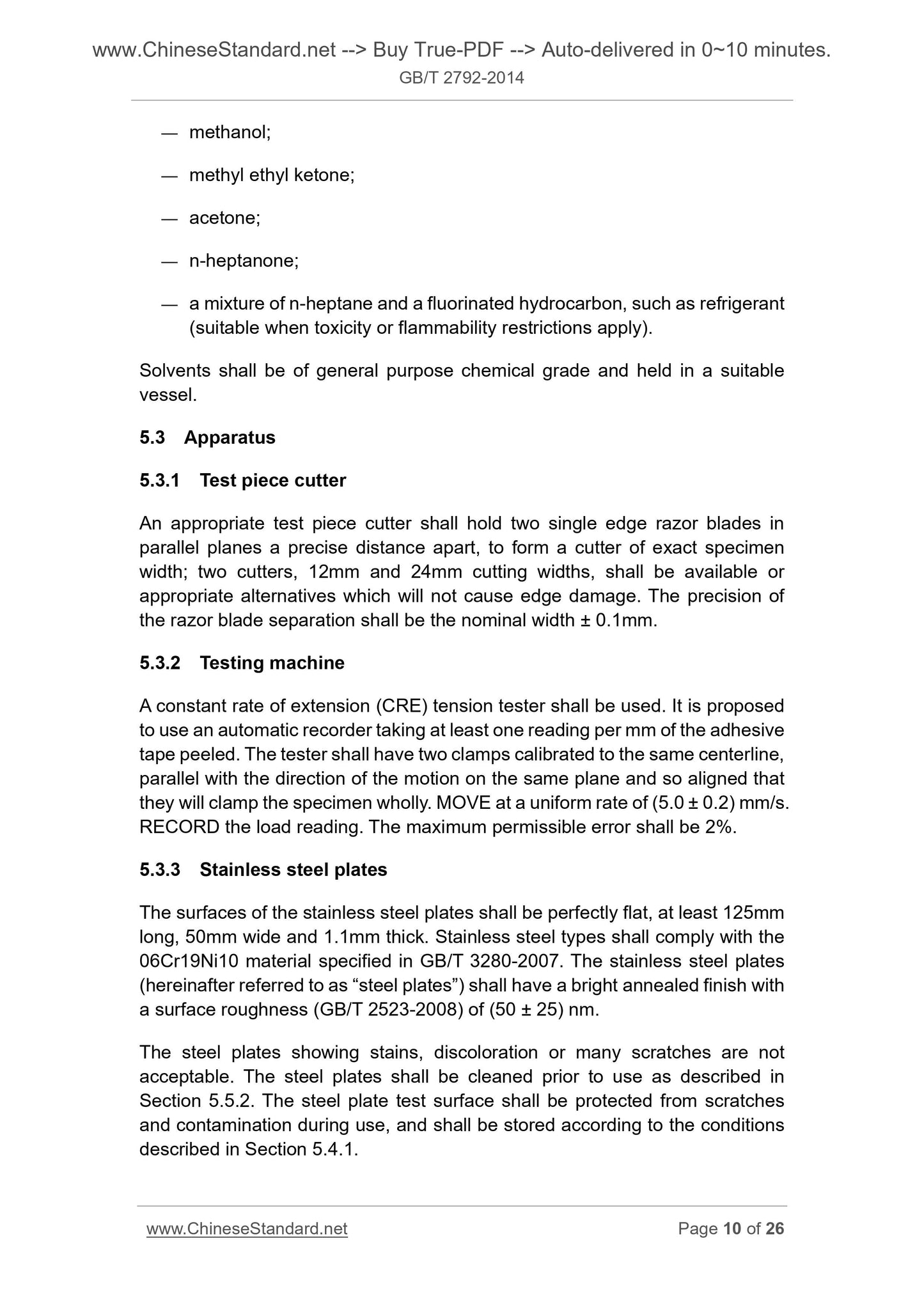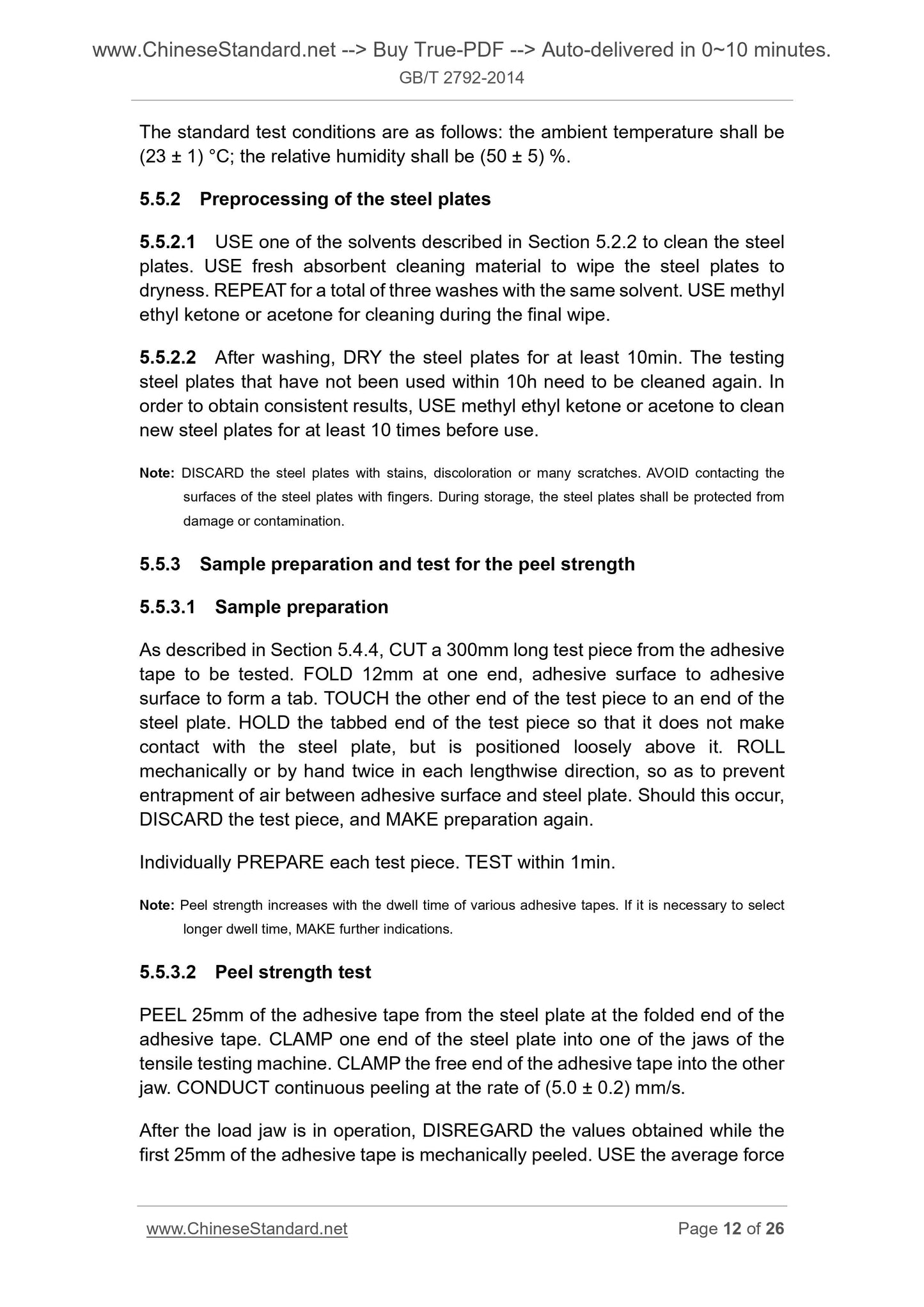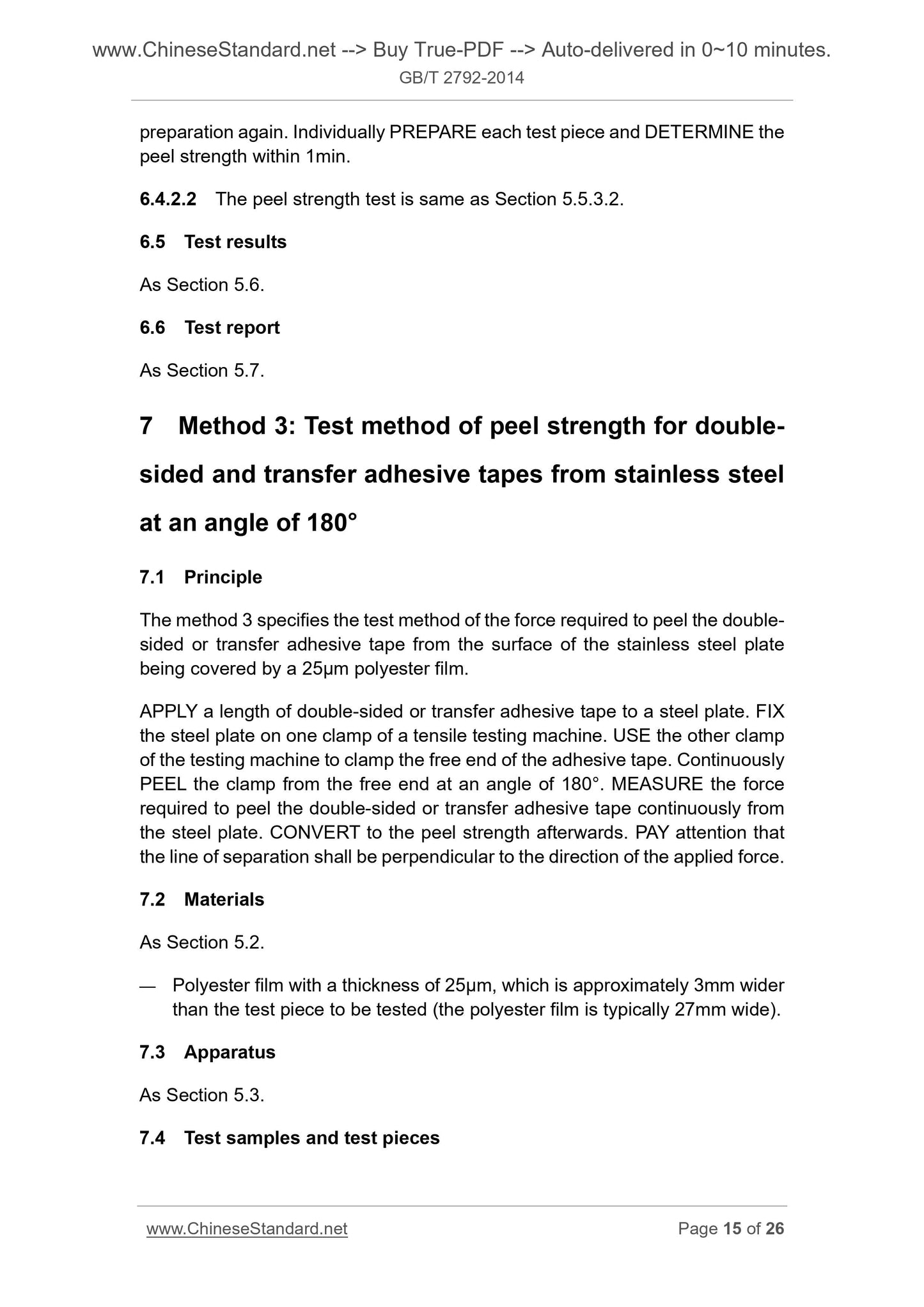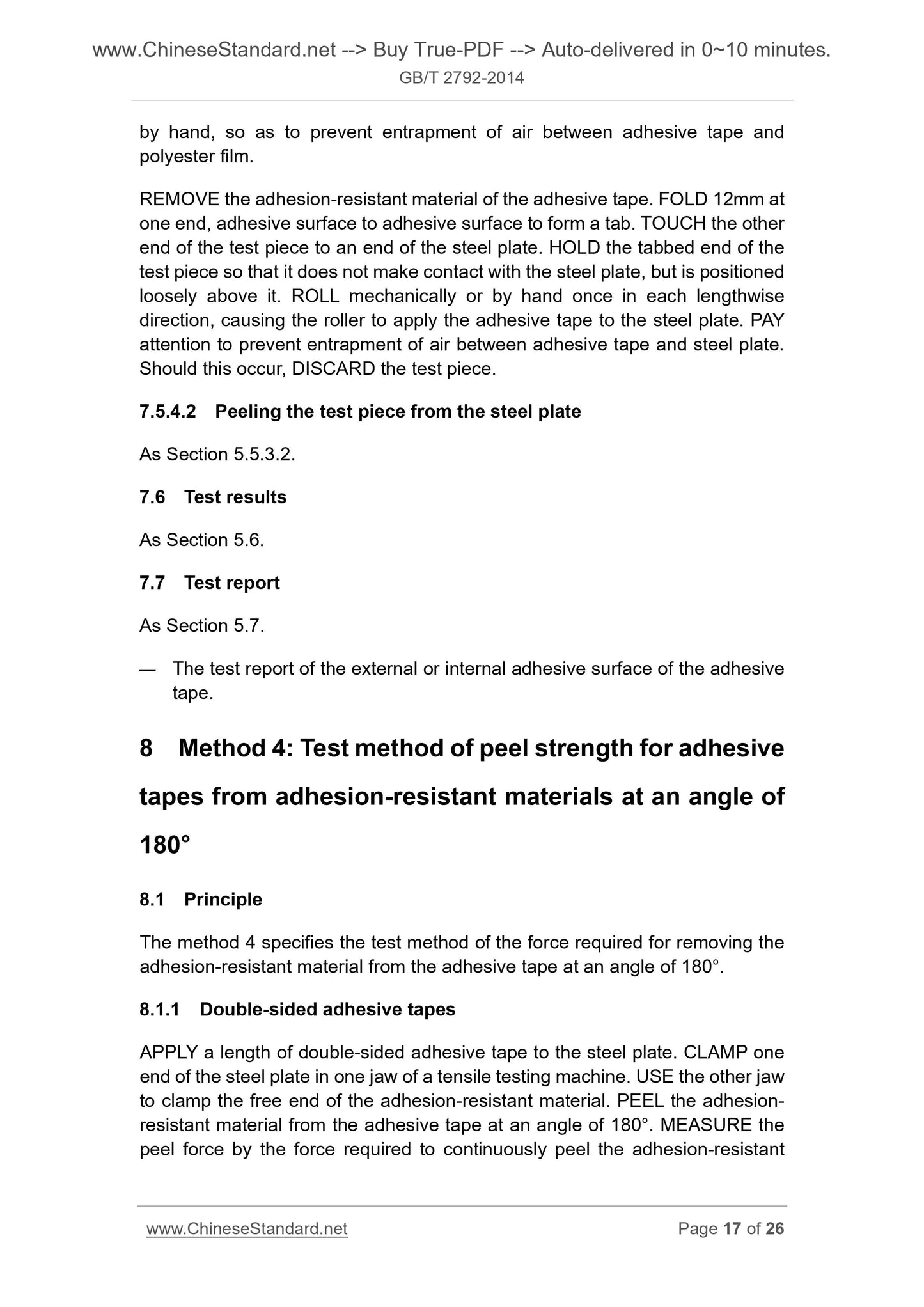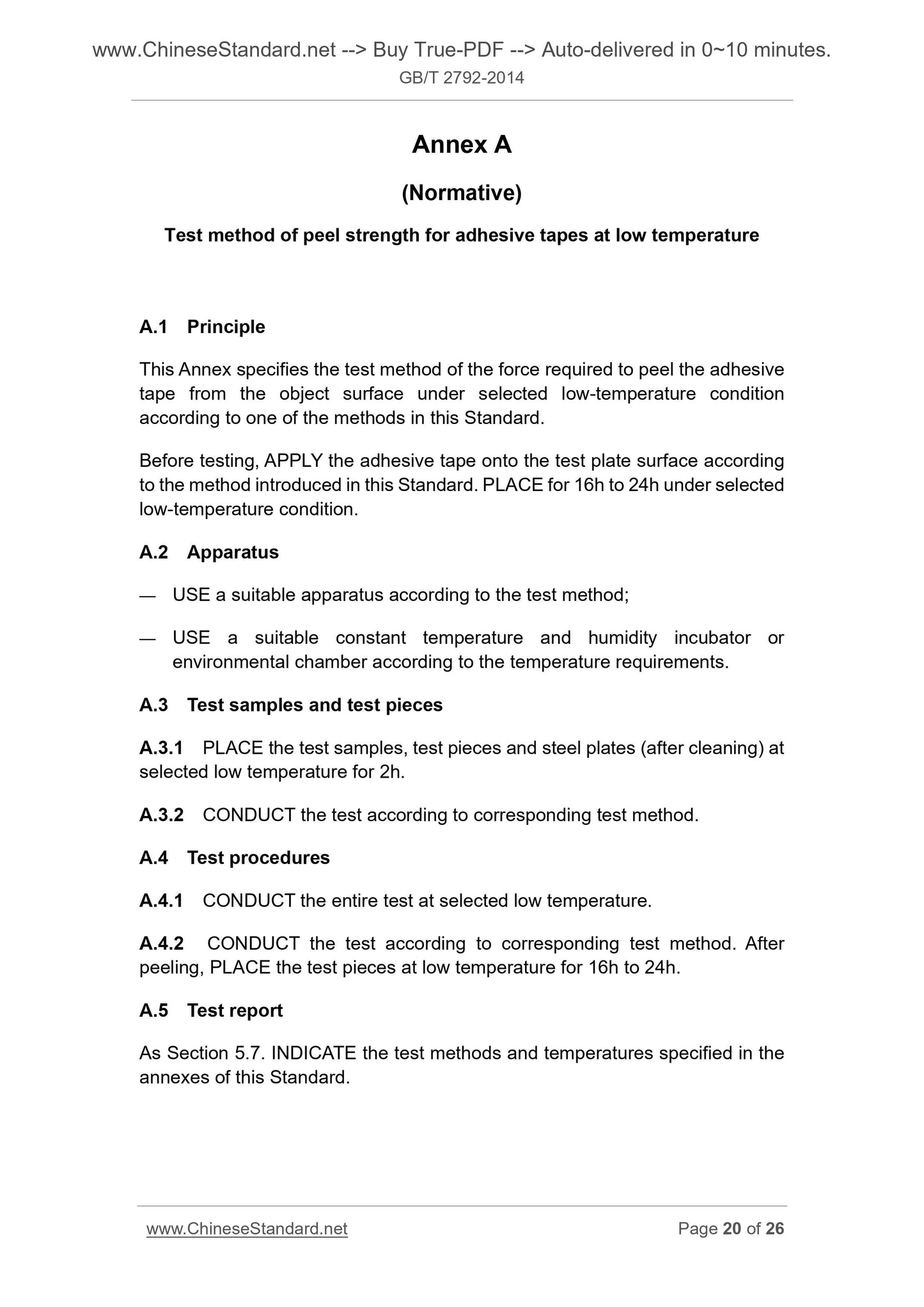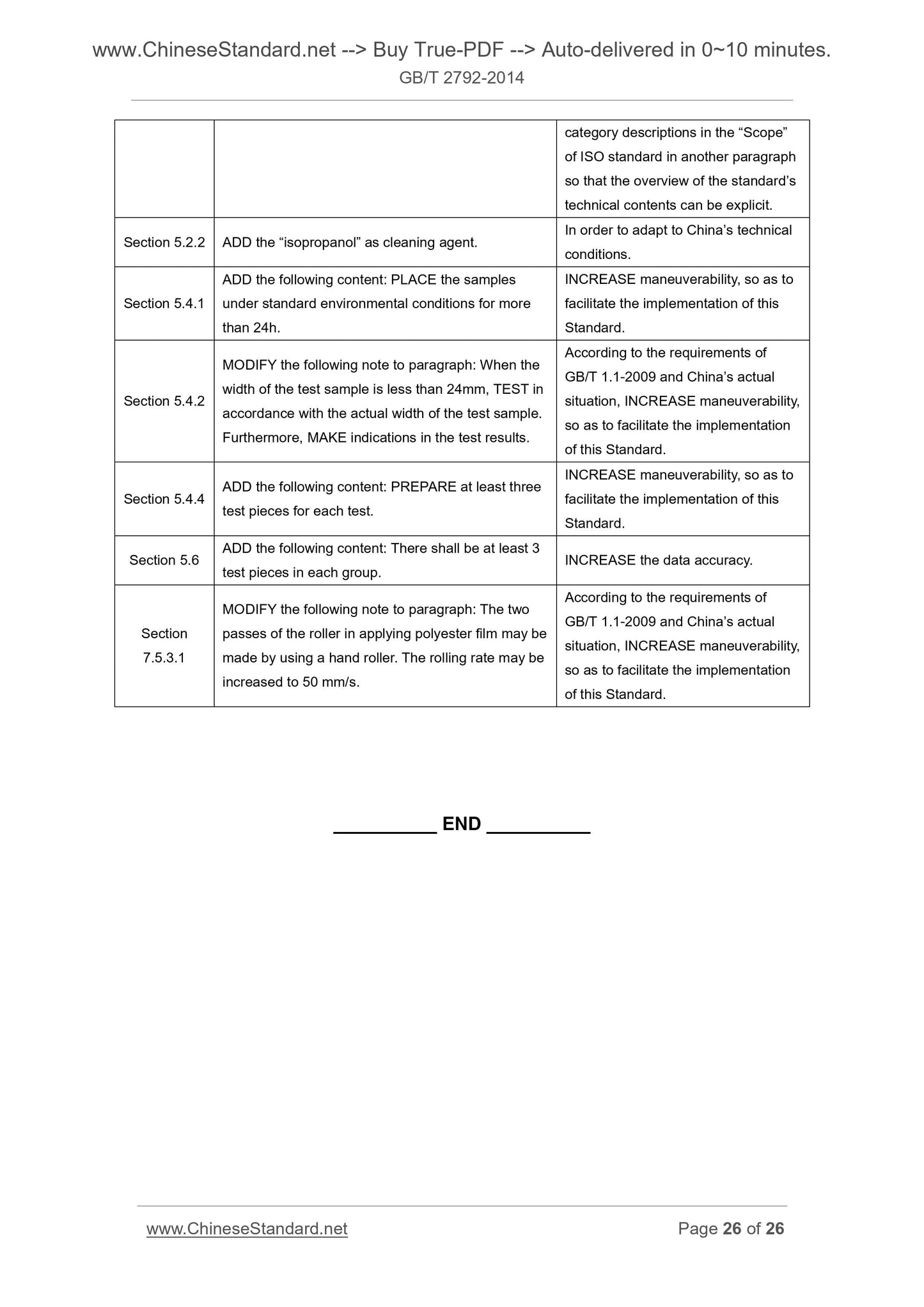1
/
of
11
PayPal, credit cards. Download editable-PDF and invoice in 1 second!
GB/T 2792-2014 English PDF (GB/T2792-2014)
GB/T 2792-2014 English PDF (GB/T2792-2014)
Regular price
$145.00 USD
Regular price
Sale price
$145.00 USD
Unit price
/
per
Shipping calculated at checkout.
Couldn't load pickup availability
Delivery: 3 seconds. Download true-PDF + Invoice.
Get Quotation: Click GB/T 2792-2014 (Self-service in 1-minute)
Historical versions (Master-website): GB/T 2792-2014
Preview True-PDF (Reload/Scroll-down if blank)
GB/T 2792-2014: Measurement of peel adhesion properties for adhesive tapes
GB/T 2792-2014
GB
NATIONAL STANDARD OF THE
PEOPLE’S REPUBLIC OF CHINA
ICS 83.180
G 38
Replacing GB/T 2792-1998
Measurement of peel adhesion properties for adhesive tapes
(ISO 29862.2007, Self adhesive tapes - Determination of peel
adhesion properties, MOD)
ISSUED ON. JULY 8, 2014
IMPLEMENTED ON. DECEMBER 1, 2014
Issued by. General Administration of Quality Supervision, Inspection and
Quarantine of the People’s Republic of China;
Standardization Administration of the People’s Republic of
China.
Table of Contents
Foreword ... 4
1 Scope ... 7
2 Normative references ... 7
3 Terms and definitions ... 7
4 Classification ... 8
5 Method 1. Test method of peel strength for adhesive tapes from stainless
steel at an angle of 180° ... 9
6 Method 2. Test method of peel strength for adhesive tapes from their own
backings at an angle of 180° ... 13
7 Method 3. Test method of peel strength for double-sided and transfer
adhesive tapes from stainless steel at an angle of 180° ... 15
8 Method 4. Test method of peel strength for adhesive tapes from adhesion-
resistant materials at an angle of 180° ... 17
Annex A (Normative) Test method of peel strength for adhesive tapes at low
temperature... 20
Annex B (Normative) Test method of peel strength for adhesive tapes at an
angle of 90° ... 21
Annex C (Informative) Structural variations in this Standard compared with
ISO 29862.2007 ... 24
Annex D (Informative) Technical differences between this Standard and
ISO 29862.2007 and corresponding causes ... 25
Foreword
This Standard was drafted in accordance with the rules given in GB/T 1.1-2009.
This Standard replaces GB/T 2792-1998 Test method for peel strength of
pressure-sensitive tape at 180° angle. Compared with GB/T 2792-1998, the
major technical changes are as follows.
— MODIFY the standard name to Measurement of peel adhesion properties
for adhesive tapes;
— DELETE the reference standard JB/T 7499-1994 Waterproof abrasive
paper (SEE Chapter 2 of 1998 edition);
— MODIFY the definition of the term “peel strength” (SEE Section 3.1 in
Chapter 3 of 1998 edition);
— ADD the term “test assembly” (SEE Section 3.2 of this Standard);
— ADD the term “roughness average” (SEE Section 3.3 of this Standard);
— MODIFY the types of cleaning agents (SEE Section 5.2.2 of this Standard,
Section 5.3.1 of 1998 edition);
— ADD the sample cutting method (SEE Section 5.3.1 of this Standard);
— MODIFY the requirements of standard test plates (SEE Section 5.3.3 of
this Standard, Section 5.2 of 1998 edition);
— MODIFY the dimensions and mass of the roller (SEE Section 5.3.4.1 of
this Standard, Sections 4.1.1 and 4.1.3 of 1998 edition);
— MODIFY the standard test conditions for laboratory (SEE Section 5.4.1
of this Standard, Section 6.2 of 1998 edition);
— MODIFY the standard sample dimensions (SEE Section 5.4.2 of this
Standard, Section 5.1 of 1998 edition);
— ADD the cleaning method of steel plates (SEE Section 5.5.2.1 of this
Standard);
— MODIFY the number of press rolls (SEE Section 5.5.3.1 of this Standard,
Section 7.3 of 1998 edition);
— MODIFY the sample preparation time and the dwell time before testing
(SEE Section 5.5.3.1 of this Standard, Section 7.4 of 1998 edition);
Measurement of peel adhesion
properties for adhesive tapes
1 Scope
This Standard specifies a series of test methods for the peel strength of
adhesive tapes.
This Standard is applicable to the determination of peel strength of adhesive
tapes, and is also used for controlling the quality of adhesive tapes.
2 Normative references
The following documents are essential to the application of this document. For
dated references, only the editions with the dates indicated are applicable to
this document. For undated references, only the latest editions (including all the
amendments) are applicable to this document.
GB/T 2523-2008 Measuring method of surface roughness and peak count
for cold-rolled metal sheet (strip)
GB/T 3280-2007 Cold-rolled stainless steel plate, sheet and strip
GB/T 22396 Terminology relating to pressure sensitive adhesive products
3 Terms and definitions
The terms and definitions defined in GB/T 22396 and the following ones are
applicable to this document.
3.1 Peel strength
It refers to the force required to peel a unit width of adhesive tape from a specific
adhesive surface at a specified angle and speed, in unit of N/cm.
3.2 Test assembly
It refers to the assembly formed by pasting the adhesive tape to be tested
behind the steel plate.
3.3 Roughness average
— methanol;
— methyl ethyl ketone;
— acetone;
— n-heptanone;
— a mixture of n-heptane and a fluorinated hydrocarbon, such as refrigerant
(suitable when toxicity or flammability restrictions apply).
Solvents shall be of general purpose chemical grade and held in a suitable
vessel.
5.3 Apparatus
5.3.1 Test piece cutter
An appropriate test piece cutter shall hold two single edge razor blades in
parallel planes a precise distance apart, to form a cutter of exact specimen
width; two cutters, 12mm and 24mm cutting widths, shall be available or
appropriate alternatives which will not cause edge damage. The precision of
the razor blade separation shall be the nominal width ± 0.1mm.
5.3.2 Testing machine
A constant rate of extension (CRE) tension tester shall be used. It is proposed
to use an automatic recorder taking at least one reading per mm of the adhesive
tape peeled. The tester shall have two clamps calibrated to the same centerline,
parallel with the direction of the motion on the same plane and so aligned that
they will clamp the specimen wholly. MOVE at a uniform rate of (5.0 ± 0.2) mm/s.
RECORD the load reading. The maximum permissible error shall be 2%.
5.3.3 Stainless steel plates
The surfaces of the stainless steel plates shall be perfectly flat, at least 125mm
long, 50mm wide and 1.1mm thick. Stainless steel types shall comply with the
06Cr19Ni10 material specified in GB/T 3280-2007. The stainless steel plates
(hereinafter referred to as “steel plates”) shall have a bright annealed finish with
a surface roughness (GB/T 2523-2008) of (50 ± 25) nm.
The steel plates showing stains, discoloration or many scratches are not
acceptable. The steel plates shall be cleaned prior to use as described in
Section 5.5.2. The steel plate test surface shall be protected from scratches
and contamination during use, and shall be stored according to the conditions
described in Section 5.4.1.
The standard test conditions are as follows. the ambient temperature shall be
(23 ± 1) °C; the relative humidity shall be (50 ± 5) %.
5.5.2 Preprocessing of the steel plates
5.5.2.1 USE one of the solvents described in Section 5.2.2 to clean the steel
plates. USE fresh absorbent cleaning material to wipe the steel plates to
dryness. REPEAT for a total of three washes with the same solvent. USE methyl
ethyl ketone or acetone for cleaning during the final wipe.
5.5.2.2 After washing, DRY the steel plates for at least 10min. The testing
steel plates that have not been used within 10h need to be cleaned again. In
order to obtain consistent results, USE methyl ethyl ketone or acetone to clean
new steel plates for at least 10 times before use.
Note. DISCARD the steel plates with stains, discoloration or many scratches. AVOID contacting the
surfaces of the steel plates with fingers. During storage, the steel plates shall be protected from
damage or contamination.
5.5.3 Sample preparation and test for the peel strength
5.5.3.1 Sample preparation
As described in Section 5.4.4, CUT a 300mm long test piece from the adhesive
tape to be tested. FOLD 12mm at one end, adhesive surface to adhesive
surface to form a tab. TOUCH the other end of the test piece to an end of the
steel plate. HOLD the tabbed end of the test piece so that it does not make
contact with the steel plate, but is positioned loosely above it. ROLL
mechanically or by hand twice in each lengthwise direction, so as to prevent
entrapment of air between adhesive surface and steel plate. Should this occur,
DISCARD the test piece, and MAKE preparation again.
Individually PREPARE each test piece. TEST within 1min.
Note. Peel strength increases with the dwell time of various adhesive tapes. If it is necessary to select
longer dwell time, MAKE further indications.
5.5.3.2 Peel strength test
PEEL 25mm of the adhesive tape from the steel plate at the folded end of the
adhesive tape. CLAMP one end of the steel plate into one of the jaws of the
tensile testing machine. CLAMP the free end of the adhesive tape into the other
jaw. CONDUCT continuous peeling at the rate of (5.0 ± 0.2) mm/s.
After the load jaw is in operation, DISREGARD the values obtained while the
...
GB/T 2792-2014
GB
NATIONAL STANDARD OF THE
PEOPLE’S REPUBLIC OF CHINA
ICS 83.180
G 38
Replacing GB/T 2792-1998
Measurement of peel adhesion properties for adhesive tapes
(ISO 29862.2007, Self adhesive tapes - Determination of peel
adhesion properties, MOD)
ISSUED ON. JULY 8, 2014
IMPLEMENTED ON. DECEMBER 1, 2014
Issued by. General Administration of Quality Supervision, Inspection and
Quarantine of the People’s Republic of China;
Standardization Administration of the People’s Republic of
China.
Table of Contents
Foreword ... 4
1 Scope ... 7
2 Normative references ... 7
3 Terms and definitions ... 7
4 Classification ... 8
5 Method 1. Test method of peel strength for adhesive tapes from stainless
steel at an angle of 180° ... 9
6 Method 2. Test method of peel strength for adhesive tapes from their own
backings at an angle of 180° ... 13
7 Method 3. Test method of peel strength for double-sided and transfer
adhesive tapes from stainless steel at an angle of 180° ... 15
8 Method 4. Test method of peel strength for adhesive tapes from adhesion-
resistant materials at an angle of 180° ... 17
Annex A (Normative) Test method of peel strength for adhesive tapes at low
temperature... 20
Annex B (Normative) Test method of peel strength for adhesive tapes at an
angle of 90° ... 21
Annex C (Informative) Structural variations in this Standard compared with
ISO 29862.2007 ... 24
Annex D (Informative) Technical differences between this Standard and
ISO 29862.2007 and corresponding causes ... 25
Foreword
This Standard was drafted in accordance with the rules given in GB/T 1.1-2009.
This Standard replaces GB/T 2792-1998 Test method for peel strength of
pressure-sensitive tape at 180° angle. Compared with GB/T 2792-1998, the
major technical changes are as follows.
— MODIFY the standard name to Measurement of peel adhesion properties
for adhesive tapes;
— DELETE the reference standard JB/T 7499-1994 Waterproof abrasive
paper (SEE Chapter 2 of 1998 edition);
— MODIFY the definition of the term “peel strength” (SEE Section 3.1 in
Chapter 3 of 1998 edition);
— ADD the term “test assembly” (SEE Section 3.2 of this Standard);
— ADD the term “roughness average” (SEE Section 3.3 of this Standard);
— MODIFY the types of cleaning agents (SEE Section 5.2.2 of this Standard,
Section 5.3.1 of 1998 edition);
— ADD the sample cutting method (SEE Section 5.3.1 of this Standard);
— MODIFY the requirements of standard test plates (SEE Section 5.3.3 of
this Standard, Section 5.2 of 1998 edition);
— MODIFY the dimensions and mass of the roller (SEE Section 5.3.4.1 of
this Standard, Sections 4.1.1 and 4.1.3 of 1998 edition);
— MODIFY the standard test conditions for laboratory (SEE Section 5.4.1
of this Standard, Section 6.2 of 1998 edition);
— MODIFY the standard sample dimensions (SEE Section 5.4.2 of this
Standard, Section 5.1 of 1998 edition);
— ADD the cleaning method of steel plates (SEE Section 5.5.2.1 of this
Standard);
— MODIFY the number of press rolls (SEE Section 5.5.3.1 of this Standard,
Section 7.3 of 1998 edition);
— MODIFY the sample preparation time and the dwell time before testing
(SEE Section 5.5.3.1 of this Standard, Section 7.4 of 1998 edition);
Measurement of peel adhesion
properties for adhesive tapes
1 Scope
This Standard specifies a series of test methods for the peel strength of
adhesive tapes.
This Standard is applicable to the determination of peel strength of adhesive
tapes, and is also used for controlling the quality of adhesive tapes.
2 Normative references
The following documents are essential to the application of this document. For
dated references, only the editions with the dates indicated are applicable to
this document. For undated references, only the latest editions (including all the
amendments) are applicable to this document.
GB/T 2523-2008 Measuring method of surface roughness and peak count
for cold-rolled metal sheet (strip)
GB/T 3280-2007 Cold-rolled stainless steel plate, sheet and strip
GB/T 22396 Terminology relating to pressure sensitive adhesive products
3 Terms and definitions
The terms and definitions defined in GB/T 22396 and the following ones are
applicable to this document.
3.1 Peel strength
It refers to the force required to peel a unit width of adhesive tape from a specific
adhesive surface at a specified angle and speed, in unit of N/cm.
3.2 Test assembly
It refers to the assembly formed by pasting the adhesive tape to be tested
behind the steel plate.
3.3 Roughness average
— methanol;
— methyl ethyl ketone;
— acetone;
— n-heptanone;
— a mixture of n-heptane and a fluorinated hydrocarbon, such as refrigerant
(suitable when toxicity or flammability restrictions apply).
Solvents shall be of general purpose chemical grade and held in a suitable
vessel.
5.3 Apparatus
5.3.1 Test piece cutter
An appropriate test piece cutter shall hold two single edge razor blades in
parallel planes a precise distance apart, to form a cutter of exact specimen
width; two cutters, 12mm and 24mm cutting widths, sh...
Get Quotation: Click GB/T 2792-2014 (Self-service in 1-minute)
Historical versions (Master-website): GB/T 2792-2014
Preview True-PDF (Reload/Scroll-down if blank)
GB/T 2792-2014: Measurement of peel adhesion properties for adhesive tapes
GB/T 2792-2014
GB
NATIONAL STANDARD OF THE
PEOPLE’S REPUBLIC OF CHINA
ICS 83.180
G 38
Replacing GB/T 2792-1998
Measurement of peel adhesion properties for adhesive tapes
(ISO 29862.2007, Self adhesive tapes - Determination of peel
adhesion properties, MOD)
ISSUED ON. JULY 8, 2014
IMPLEMENTED ON. DECEMBER 1, 2014
Issued by. General Administration of Quality Supervision, Inspection and
Quarantine of the People’s Republic of China;
Standardization Administration of the People’s Republic of
China.
Table of Contents
Foreword ... 4
1 Scope ... 7
2 Normative references ... 7
3 Terms and definitions ... 7
4 Classification ... 8
5 Method 1. Test method of peel strength for adhesive tapes from stainless
steel at an angle of 180° ... 9
6 Method 2. Test method of peel strength for adhesive tapes from their own
backings at an angle of 180° ... 13
7 Method 3. Test method of peel strength for double-sided and transfer
adhesive tapes from stainless steel at an angle of 180° ... 15
8 Method 4. Test method of peel strength for adhesive tapes from adhesion-
resistant materials at an angle of 180° ... 17
Annex A (Normative) Test method of peel strength for adhesive tapes at low
temperature... 20
Annex B (Normative) Test method of peel strength for adhesive tapes at an
angle of 90° ... 21
Annex C (Informative) Structural variations in this Standard compared with
ISO 29862.2007 ... 24
Annex D (Informative) Technical differences between this Standard and
ISO 29862.2007 and corresponding causes ... 25
Foreword
This Standard was drafted in accordance with the rules given in GB/T 1.1-2009.
This Standard replaces GB/T 2792-1998 Test method for peel strength of
pressure-sensitive tape at 180° angle. Compared with GB/T 2792-1998, the
major technical changes are as follows.
— MODIFY the standard name to Measurement of peel adhesion properties
for adhesive tapes;
— DELETE the reference standard JB/T 7499-1994 Waterproof abrasive
paper (SEE Chapter 2 of 1998 edition);
— MODIFY the definition of the term “peel strength” (SEE Section 3.1 in
Chapter 3 of 1998 edition);
— ADD the term “test assembly” (SEE Section 3.2 of this Standard);
— ADD the term “roughness average” (SEE Section 3.3 of this Standard);
— MODIFY the types of cleaning agents (SEE Section 5.2.2 of this Standard,
Section 5.3.1 of 1998 edition);
— ADD the sample cutting method (SEE Section 5.3.1 of this Standard);
— MODIFY the requirements of standard test plates (SEE Section 5.3.3 of
this Standard, Section 5.2 of 1998 edition);
— MODIFY the dimensions and mass of the roller (SEE Section 5.3.4.1 of
this Standard, Sections 4.1.1 and 4.1.3 of 1998 edition);
— MODIFY the standard test conditions for laboratory (SEE Section 5.4.1
of this Standard, Section 6.2 of 1998 edition);
— MODIFY the standard sample dimensions (SEE Section 5.4.2 of this
Standard, Section 5.1 of 1998 edition);
— ADD the cleaning method of steel plates (SEE Section 5.5.2.1 of this
Standard);
— MODIFY the number of press rolls (SEE Section 5.5.3.1 of this Standard,
Section 7.3 of 1998 edition);
— MODIFY the sample preparation time and the dwell time before testing
(SEE Section 5.5.3.1 of this Standard, Section 7.4 of 1998 edition);
Measurement of peel adhesion
properties for adhesive tapes
1 Scope
This Standard specifies a series of test methods for the peel strength of
adhesive tapes.
This Standard is applicable to the determination of peel strength of adhesive
tapes, and is also used for controlling the quality of adhesive tapes.
2 Normative references
The following documents are essential to the application of this document. For
dated references, only the editions with the dates indicated are applicable to
this document. For undated references, only the latest editions (including all the
amendments) are applicable to this document.
GB/T 2523-2008 Measuring method of surface roughness and peak count
for cold-rolled metal sheet (strip)
GB/T 3280-2007 Cold-rolled stainless steel plate, sheet and strip
GB/T 22396 Terminology relating to pressure sensitive adhesive products
3 Terms and definitions
The terms and definitions defined in GB/T 22396 and the following ones are
applicable to this document.
3.1 Peel strength
It refers to the force required to peel a unit width of adhesive tape from a specific
adhesive surface at a specified angle and speed, in unit of N/cm.
3.2 Test assembly
It refers to the assembly formed by pasting the adhesive tape to be tested
behind the steel plate.
3.3 Roughness average
— methanol;
— methyl ethyl ketone;
— acetone;
— n-heptanone;
— a mixture of n-heptane and a fluorinated hydrocarbon, such as refrigerant
(suitable when toxicity or flammability restrictions apply).
Solvents shall be of general purpose chemical grade and held in a suitable
vessel.
5.3 Apparatus
5.3.1 Test piece cutter
An appropriate test piece cutter shall hold two single edge razor blades in
parallel planes a precise distance apart, to form a cutter of exact specimen
width; two cutters, 12mm and 24mm cutting widths, shall be available or
appropriate alternatives which will not cause edge damage. The precision of
the razor blade separation shall be the nominal width ± 0.1mm.
5.3.2 Testing machine
A constant rate of extension (CRE) tension tester shall be used. It is proposed
to use an automatic recorder taking at least one reading per mm of the adhesive
tape peeled. The tester shall have two clamps calibrated to the same centerline,
parallel with the direction of the motion on the same plane and so aligned that
they will clamp the specimen wholly. MOVE at a uniform rate of (5.0 ± 0.2) mm/s.
RECORD the load reading. The maximum permissible error shall be 2%.
5.3.3 Stainless steel plates
The surfaces of the stainless steel plates shall be perfectly flat, at least 125mm
long, 50mm wide and 1.1mm thick. Stainless steel types shall comply with the
06Cr19Ni10 material specified in GB/T 3280-2007. The stainless steel plates
(hereinafter referred to as “steel plates”) shall have a bright annealed finish with
a surface roughness (GB/T 2523-2008) of (50 ± 25) nm.
The steel plates showing stains, discoloration or many scratches are not
acceptable. The steel plates shall be cleaned prior to use as described in
Section 5.5.2. The steel plate test surface shall be protected from scratches
and contamination during use, and shall be stored according to the conditions
described in Section 5.4.1.
The standard test conditions are as follows. the ambient temperature shall be
(23 ± 1) °C; the relative humidity shall be (50 ± 5) %.
5.5.2 Preprocessing of the steel plates
5.5.2.1 USE one of the solvents described in Section 5.2.2 to clean the steel
plates. USE fresh absorbent cleaning material to wipe the steel plates to
dryness. REPEAT for a total of three washes with the same solvent. USE methyl
ethyl ketone or acetone for cleaning during the final wipe.
5.5.2.2 After washing, DRY the steel plates for at least 10min. The testing
steel plates that have not been used within 10h need to be cleaned again. In
order to obtain consistent results, USE methyl ethyl ketone or acetone to clean
new steel plates for at least 10 times before use.
Note. DISCARD the steel plates with stains, discoloration or many scratches. AVOID contacting the
surfaces of the steel plates with fingers. During storage, the steel plates shall be protected from
damage or contamination.
5.5.3 Sample preparation and test for the peel strength
5.5.3.1 Sample preparation
As described in Section 5.4.4, CUT a 300mm long test piece from the adhesive
tape to be tested. FOLD 12mm at one end, adhesive surface to adhesive
surface to form a tab. TOUCH the other end of the test piece to an end of the
steel plate. HOLD the tabbed end of the test piece so that it does not make
contact with the steel plate, but is positioned loosely above it. ROLL
mechanically or by hand twice in each lengthwise direction, so as to prevent
entrapment of air between adhesive surface and steel plate. Should this occur,
DISCARD the test piece, and MAKE preparation again.
Individually PREPARE each test piece. TEST within 1min.
Note. Peel strength increases with the dwell time of various adhesive tapes. If it is necessary to select
longer dwell time, MAKE further indications.
5.5.3.2 Peel strength test
PEEL 25mm of the adhesive tape from the steel plate at the folded end of the
adhesive tape. CLAMP one end of the steel plate into one of the jaws of the
tensile testing machine. CLAMP the free end of the adhesive tape into the other
jaw. CONDUCT continuous peeling at the rate of (5.0 ± 0.2) mm/s.
After the load jaw is in operation, DISREGARD the values obtained while the
...
GB/T 2792-2014
GB
NATIONAL STANDARD OF THE
PEOPLE’S REPUBLIC OF CHINA
ICS 83.180
G 38
Replacing GB/T 2792-1998
Measurement of peel adhesion properties for adhesive tapes
(ISO 29862.2007, Self adhesive tapes - Determination of peel
adhesion properties, MOD)
ISSUED ON. JULY 8, 2014
IMPLEMENTED ON. DECEMBER 1, 2014
Issued by. General Administration of Quality Supervision, Inspection and
Quarantine of the People’s Republic of China;
Standardization Administration of the People’s Republic of
China.
Table of Contents
Foreword ... 4
1 Scope ... 7
2 Normative references ... 7
3 Terms and definitions ... 7
4 Classification ... 8
5 Method 1. Test method of peel strength for adhesive tapes from stainless
steel at an angle of 180° ... 9
6 Method 2. Test method of peel strength for adhesive tapes from their own
backings at an angle of 180° ... 13
7 Method 3. Test method of peel strength for double-sided and transfer
adhesive tapes from stainless steel at an angle of 180° ... 15
8 Method 4. Test method of peel strength for adhesive tapes from adhesion-
resistant materials at an angle of 180° ... 17
Annex A (Normative) Test method of peel strength for adhesive tapes at low
temperature... 20
Annex B (Normative) Test method of peel strength for adhesive tapes at an
angle of 90° ... 21
Annex C (Informative) Structural variations in this Standard compared with
ISO 29862.2007 ... 24
Annex D (Informative) Technical differences between this Standard and
ISO 29862.2007 and corresponding causes ... 25
Foreword
This Standard was drafted in accordance with the rules given in GB/T 1.1-2009.
This Standard replaces GB/T 2792-1998 Test method for peel strength of
pressure-sensitive tape at 180° angle. Compared with GB/T 2792-1998, the
major technical changes are as follows.
— MODIFY the standard name to Measurement of peel adhesion properties
for adhesive tapes;
— DELETE the reference standard JB/T 7499-1994 Waterproof abrasive
paper (SEE Chapter 2 of 1998 edition);
— MODIFY the definition of the term “peel strength” (SEE Section 3.1 in
Chapter 3 of 1998 edition);
— ADD the term “test assembly” (SEE Section 3.2 of this Standard);
— ADD the term “roughness average” (SEE Section 3.3 of this Standard);
— MODIFY the types of cleaning agents (SEE Section 5.2.2 of this Standard,
Section 5.3.1 of 1998 edition);
— ADD the sample cutting method (SEE Section 5.3.1 of this Standard);
— MODIFY the requirements of standard test plates (SEE Section 5.3.3 of
this Standard, Section 5.2 of 1998 edition);
— MODIFY the dimensions and mass of the roller (SEE Section 5.3.4.1 of
this Standard, Sections 4.1.1 and 4.1.3 of 1998 edition);
— MODIFY the standard test conditions for laboratory (SEE Section 5.4.1
of this Standard, Section 6.2 of 1998 edition);
— MODIFY the standard sample dimensions (SEE Section 5.4.2 of this
Standard, Section 5.1 of 1998 edition);
— ADD the cleaning method of steel plates (SEE Section 5.5.2.1 of this
Standard);
— MODIFY the number of press rolls (SEE Section 5.5.3.1 of this Standard,
Section 7.3 of 1998 edition);
— MODIFY the sample preparation time and the dwell time before testing
(SEE Section 5.5.3.1 of this Standard, Section 7.4 of 1998 edition);
Measurement of peel adhesion
properties for adhesive tapes
1 Scope
This Standard specifies a series of test methods for the peel strength of
adhesive tapes.
This Standard is applicable to the determination of peel strength of adhesive
tapes, and is also used for controlling the quality of adhesive tapes.
2 Normative references
The following documents are essential to the application of this document. For
dated references, only the editions with the dates indicated are applicable to
this document. For undated references, only the latest editions (including all the
amendments) are applicable to this document.
GB/T 2523-2008 Measuring method of surface roughness and peak count
for cold-rolled metal sheet (strip)
GB/T 3280-2007 Cold-rolled stainless steel plate, sheet and strip
GB/T 22396 Terminology relating to pressure sensitive adhesive products
3 Terms and definitions
The terms and definitions defined in GB/T 22396 and the following ones are
applicable to this document.
3.1 Peel strength
It refers to the force required to peel a unit width of adhesive tape from a specific
adhesive surface at a specified angle and speed, in unit of N/cm.
3.2 Test assembly
It refers to the assembly formed by pasting the adhesive tape to be tested
behind the steel plate.
3.3 Roughness average
— methanol;
— methyl ethyl ketone;
— acetone;
— n-heptanone;
— a mixture of n-heptane and a fluorinated hydrocarbon, such as refrigerant
(suitable when toxicity or flammability restrictions apply).
Solvents shall be of general purpose chemical grade and held in a suitable
vessel.
5.3 Apparatus
5.3.1 Test piece cutter
An appropriate test piece cutter shall hold two single edge razor blades in
parallel planes a precise distance apart, to form a cutter of exact specimen
width; two cutters, 12mm and 24mm cutting widths, sh...
Share
